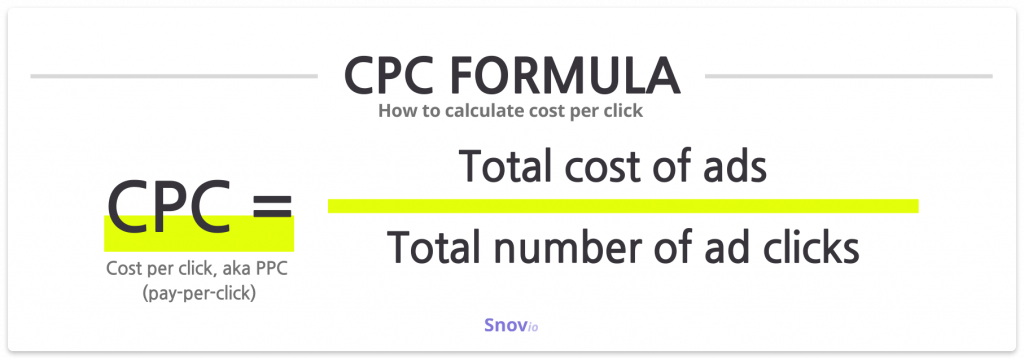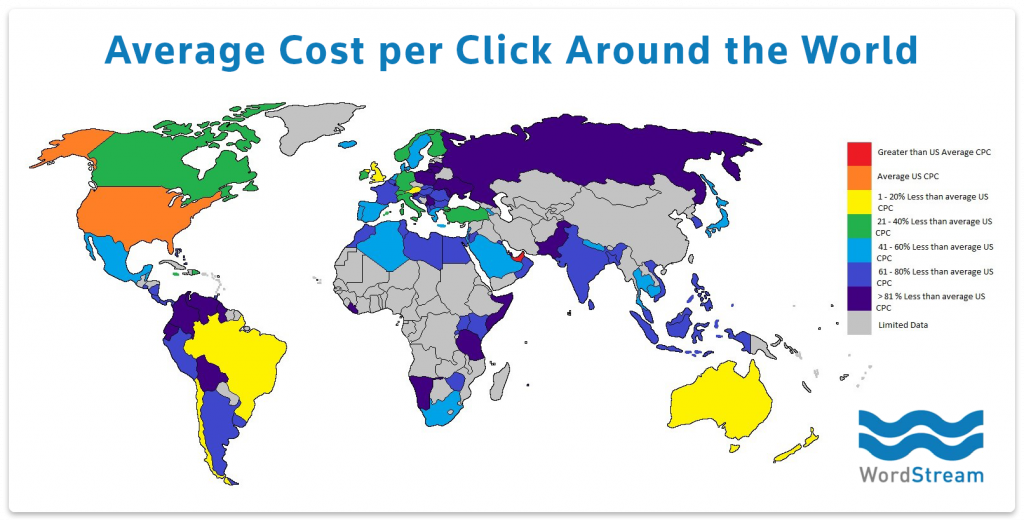Cost per click (CPC)
Cost per click, also known as CPC, (synonymous to PPC, or pay-per-click) is a web marketing method used to draw target traffic to web pages, in which an advertiser pays a publisher when a visitor clicks the ad. A publisher is usually the owner of a website, a web platform or a search engine.
Pay-per-click is often connected with top-level search engines (like Google Ads or Bing Ads). With search engines, marketers regularly bid on keywords or key phrases regularly searched by their target audience.
Conversely, content platforms charge a settled price per click instead of using a bidding method. PPC promotion, also regarded as “banner” ads, are shown on websites that contain associated content and have consented to display ads and are usually not CPC advertising. The mainstream social networking platforms such as Twitter and Facebook have implemented pay-per-click as one of their promotion methods as well.
Nevertheless, websites can also offer PPC ads. Platforms that employ PPC ads will show the ads when a key phrase query corresponds to an advertiser’s list of keywords that have been added in various ad groups, or when a content platform shows relevant content. Such ads are called sponsored links or sponsored ads. They are shown on the search engine page above, below or adjacent to the organic search results, or in any place of a content site, where a web developer decides to create an ads section.
The PPC marketing method is vulnerable to violations through click fraud. However, Google and its rivals have launched automated security systems to guard against abusive clicks by opponents or dishonest web promoters.
CPC/PPC destination
Cost per click, together with such metrics as cost per order and cost per impression, are used to estimate the economic efficiency and efficiency of web marketing campaigns.
CPC has benefits over cost per impression in that it carries details about how productive the ad posting was. Clicks are a reasonable method to gauge visitors’ attention and engagement: if the foremost goal of web promotion is to cause a click, or more precisely drive traffic to a target page, then pay-per-click is the favored metric. Once a specific quantity of web impressions is reached, the quality and position of the ad will influence click-through rates and the resulting pay-per-click.
How the CPC is calculated
Cost per click (CPC) is estimated by dividing the promotion price by the number of clicks delivered by a certain ad publication. The basic cost per click formula is:
Cost-per-click ($) = Advertisement price ($) / Ads clicked (#)

There are two basic patterns for defining pay-per-click: flat-rate and bid-based. In both cases, the promoter must analyze the potential price of a click from a provided source. This price is based on the sort of target person the promoter is anticipating to get as a visitor to their web page, and what the ad promoter can obtain from that visit, usually short term and long term income.
As with other methods of promoting targeting is essential, and factors that often influence PPC campaigns incorporate interests of the target audience (often represented by a search phrase they looked up in the search engine, or the content of a page that they are browsing), buying intention, state, city or region (for geo-targeting), and the time and date that they are browsing.

What is Flat-Rate PPC?
In accordance with the flat-rate system, the marketer and the ads publisher decide upon a fixed price that will be paid for every visitor’s click.
Quite often, the publisher has a rate card that enlists the pay-per-click (PPC) within several various areas of their website or network. These different amounts are often associated with the content on web pages, with content that generally interests more important visitors having a higher PPC than content that interests less relevant visitors.
Still, in many cases, advertisers can discuss lower prices, particularly when planning to enter into a long-term or expensive deal.
What is Bid-Based PPC?
The promoter signs an agreement that enables them to bid against other promoters in a separate auction held by the publisher of the ad or, more usually, an advertising network.
Each promoter notifies the host of the highest amount that they are ready to pay for a given ad spot (regularly based on a search keyword), customarily using online instruments to do so. The auction starts automatically every time a website visitor triggers the ad spot. When the advertising spot is a part of a SERP (search engine results page), the programmed auction occurs every time someone searches for the keyword or key phrase that is being bid upon.
The winner is determined when all the bids for the search phrase that target the user’s geographic location, the timing of the lookup, etc. are analyzed and compared. Quite often there are many different ad spots; in such cases, several winners can be determined, whose positions on the page are affected by the value of each bid.
The bid and Quality Score give each promoter’s advert an ad rank. The ad with the top ad ranking is displayed first. The leading three match varieties for both search engines, Google and Bing, are Broad, Exact and Phrase Match. Google also introduces the Broad Match Modifier standard which varies from Broad Match in that the search key phrase must include specific keyword expressions in any order and doesn’t involve relevant alterations of the terms.
History of CPC
Different companies claim to have launched the first PPC model on the web on their websites, many of them emerged in the 1990s. For instance, in 1996, the first registered version of a PPC was incorporated in a web directory named Planet Oasis. This was a desktop app produced by Ark Interface II, a branch of Packard Bell NEC Computers. Its job was to highlight links to marketing and informational websites.
Yet, the first feedback from marketing companies to the new “pay-per-visit” paradigm was skeptical. By the end of 1997, over 400 influential brands were paying between $.005 to $.25 per click plus a fee for placement.
In winter 1998, at the TED conference in California, Jeffrey Brewer from Goto.com introduced a PPC search engine POC (proof-of-concept). This crucial presentation and the subsequent events developed the PPC advertisement system. Credit for the idea of the PPC method is commonly given to Idealab and Goto.com patron Bill Gross.
Google started search engine promotions in winter 1999. In fall 2000 the AdWords system was launched, enabling merchants to create text ads for placing on the Google search engine. Nevertheless, PPC was only launched in 2002; until then, ads were charged at cost-per-thousand impressions or Cost per mille (CPM).
There was a patent violation lawsuit filed by Overture against Google. They claimed the competing search service trespassed its restrictions with its ad-placement tools.
Amongst PPC providers, the three largest network operators had been Google Ads (formerly Google AdWords), Microsoft adCenter and Yahoo! Search Marketing, all three working according to a bid-based pattern.
In 2014, PPC (Adwords) or online promotion counted for nearly $45 billion of the whole $66 billion of Google’s yearly income. In 2010, Yahoo and Microsoft started their consolidated battle against Google, and Microsoft’s Bing got to be the search tool that Yahoo used to present its search results. As they joined powers, they changed the name of their PPC platform to AdCenter. Their connected system of third party websites that enable AdCenter ads to populate banner and text advertisements on their website is called BingAds.
Legal Issues
In 2012, Google was originally alleged to have been involved in misleading and deceitful tactics by the Australian Competition & Consumer Commission (ACCC) in probably the first juridical case of its kind. The ACCC declared that Google was liable for the content of its sponsored AdWords announcements that had displayed links to a car marketing website Carsales.com. The Ads had been displayed by Google in reaction to searching for Honda Australia. The ACCC stated the ads were deceitful, as they implied Carsales.com was related to the Honda company.
The verdict was later changed when Google retried to the Australian High Court. Google was determined not accountable for the misleading ads run through AdWords despite the fact that the advertisements were provided by Google and produced using the company’s instruments.















